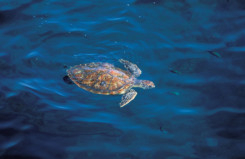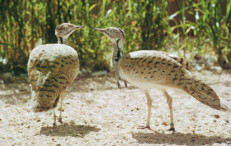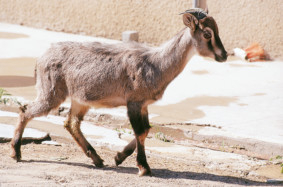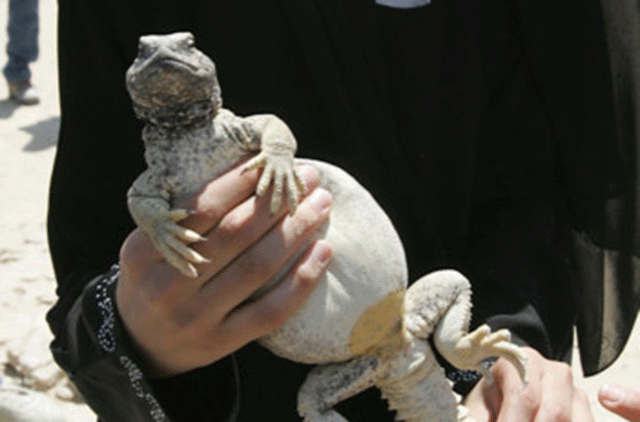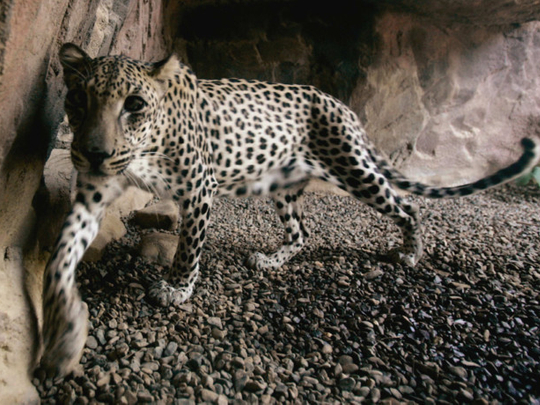
The UAE is the natural habitat for a number of beautiful animals, but many of them are the last of their kind. By placing greater focus on conservation in recent years, the country is working to protect and even breed various endangered species. We highlight six of the most vulnerable creatures found in the UAE, and how you can help prevent them from becoming just another page in a history book.
Hawksbill turtle
Status: Critically endangered
These migratory creatures are found in over 60 countries, and the UAE’s beaches – especially on Saadiyat Island in Abu Dhabi – are regular nesting grounds for them. In the past century, the hawksbill turtle has declined in population worldwide by around 80 per cent. Recent estimates by the World Wide Fund for Animals (WWF) found that there are only approximately 8,000 adult nesting females left in the world.
Threats: Hawksbill turtles are much sought after throughout the tropics for their brown and yellow carapace plates that are manufactured into tortoiseshell items, such as jewellery and ornaments. Other reasons for their decline include loss of nesting and feeding habitats due to rising water levels, excessive egg collection, fishery-related mortality, pollution, coastal development and illegal wildlife trade.
Why we should care: Apart from having cultural significance and tourism value, hawksbill turtles are vital for the preservation of coral reefs. According to US-based seeturtles.org, by consuming sponges, hawksbill turtles aid corals in growth. It is estimated that one turtle can consume over 454 kilograms of sponges per year. Without them, sponges have the ability to overgrow corals and suffocate reefs. As the largest living structures on the planet, coral reefs are among the greatest storehouses of biodiversity on Earth, acting as a home to 25 per cent of all marine species. If coral reefs are in danger – so is most aquatic life.
How you can help:
• Adopt a Turtle — Join the Marine Turtle Conservation Project, launched in 2010 by Emirates Wildlife Society in association with WWF (EWS-WWF), by signing up for their program at gulfturtles.com.
• Check Out for Turtles — Retailers, hotels, dive centres and restaurants interested in showing their support can join this initiative by asking guests to voluntarily donate Dh10 to the turtle conservation program at the time of check out.
• Those interested in offering their skills pro bono, can do so by emailing turtles@ewswwf.ae.
Arabian Leopard
Status: Critically endangered
The smallest of all 15 existing leopard species, these leopards once ranged all across the Arabian Peninsula. Now, according to the IUCN Red List, there are 250 or fewer known Arabian leopards in the wild, and they are heading towards outright extinction. Since the beginning of the 19th century, the leopards’ range has decreased by around 90 per cent in Saudi Arabia, according to US-based iNaturalist.org. Their population has been in dramatic decline in the Middle East ever since.
Threats: The Arabian leopard is threatened by habitat loss, degradation and fragmentation, and the depletion of its prey, such as the mountain gazelle and the Arabian tahr, caused by unregulated hunting. In places such as Yemen, Arabian leopards are under particular pressure from hunting, capture for trade, and retaliatory killing from local shepherds in defense of livestock. The leopards are also caught live and sold at a high price as pets or for private collections.
Why we should care: Massive conservation efforts are underway, with the region’s first captive breeding group established at the Omani Mammal Breeding Centre in Muscat in 1985, and several successful captive breeding efforts at Sharjah Breeding Centre for Endangered Arabian Wildlife ( (BCEAW). But without an extensively protected wild habitat, the future of the Arabian leopard might be in zoos and private collections – and that’s the best-case scenario for the species that is currently on the brink of extinction.
How you can help:
• Learn more – Sharjah’s BCEAW has successfully bred 35 Arabian leopards since a male from Yemen and a female from Oman were brought together in 1998. As part of Sharjah government’s Arabian leopard conservation programme launched earlier this year, the centre conducts a large number of workshops and activities to educate students of schools and universities and families on the importance of protecting the leopard’s ecosystem. Visit their website – breedingcentresharjah.com
• View Gulf News’ interactive on the Arabian leopard by clicking here.
Arabian Tahr
Status: Endangered
According to the IUCN Red List, the entire world population of the Arabian tahr occurs in the mountains of northern Oman and the UAE, where it prefers north facing slopes between 1,000 and 1,800 metres high. The IUCN estimates that there are probably fewer than 5,000 Arabian tahrs left in the world.
Threats: Intense grazing competition from livestock, illegal hunting and habitat degradation through human development have caused the species to decline severely. According to a BCEAW report in 2006, Arabian tahr populations in the UAE appear to be localised and possibly isolated. The concern is that isolation would lead to diminished genetic variation due to inbreeding, which in turn would result in increased susceptibility to disease and decreased fertility, spelling disaster for the Arabian tahr in the UAE.
Why we should care: The Arabian tahr is the region’s only large, endemic mammal. Conservation initiatives have helped slowly combat the declining numbers of the Arabian tahr, but researchers say it will take efforts on a much larger scale to stabilise its waning population.
How you can help:
• Educate yourself – The tahrs’ home terrain of Wadi Wurayah in Fujairah was officially declared as the UAE’s first protected mountain area in 2009, and there are currently three dedicated institutions involved in the captive breeding of this species in Oman and UAE. The Management of Nature Conservation (MNC) in Al Ain now houses over 425 Arabian tahrs, believed to be the world’s biggest Arabian tahr population in captivity, up from 10 in 2005.
Spiny-tailed lizard
Status: Vulnerable
Native to the UAE and other regions of the Middle East such as Egypt, Jordan and Saudi Arabia, the spiny-tailed lizard, locally known as the ‘dhub’, is on its way to becoming endangered. There has been a population decline of over 30 per cent over the past three generations, and this is expected to increase to 50 per cent in the future, according to the International Union for Conservation of Nature (IUCN).
Threats: In Egypt, large portions of the lizards’ habitat have been lost to quarrying for gravel and building material, especially in desert areas. The lizards are also used for food and medicinal purposes.
Dr Jaime Samour, an Abu Dhabi-based specialist in zoological medicine, told Gulf News: “Loss of habitat, chain-linked fencing around farms and other properties, trampling burrows by four-wheel drives and trapping for illegal trade have all been responsible for considerably reducing this native lizard species in the UAE. In some countries in the Middle East, this lizard is in great demand as a delicacy and can be bought freely in animal markets.”
Why we should care: Often known as ‘samakat al sahra’ or ‘fish of the desert’ and even termed ‘little dinosaur’ or ‘dragon’, the spiny-tailed lizard is a variation in a species that has lasted for millions of years. Much of early lizard evolution is thought to have occurred during the Jurassic and Cretaceous ages, when the continents as we now know them, were once part of a supercontinent called Pangaea. That was approximately 150 million years ago, according to authors of ‘Lizards: Windows to the Evolution of Diversity’, Eric R. Pianka and Laurie J. Vitt. Should these lizards’ fascinating journey through time meet such an abrupt end?
How you can help:
• Educate yourself — You can see the spiny-tailed lizard live and learn more about it by visiting Abu Dhabi’s Al Wathba Wetland Reserve, an internationally recognised wetland and protected area, where visitors can learn about the local biodiversity.
• Modify your actions — Dr Samour advises people to let lizards be undisturbed. He said: “Be aware of the presence of lizard communities and avoid camping and driving across their territory. Advise neighbours or visitors to the area of the existence of a lizard colony.”
• Learn more — Contact BCEAW, which serves not just to protect vulnerable species like the spiny tailed lizard, but also to serve as a base for research. While BCEAW is closed to the public, its other facilities — the Sharjah Desert Park, Sharjah Natural History Museum and Children’s Farm and Arabia Wildlife Centre — are open to visitors. Visit breedingcentresharjah.com.
• View Gulf News’ interactive on the spiny tailed lizard by clicking here.
Socotra Cormorant
Status: Vulnerable
This species of birds breeds on islands off the Arabian Gulf coasts of Bahrain, UAE, Saudi Arabia and neighbouring countries. The breeding population is estimated at 110,000 pairs, and is steadily decreasing in number. While at first glance, its numbers seem to be relatively large, the socotra cormorant faces a grim fate due to its position as an extremely restricted population, found in a total of just nine locations — all of them in the Middle East.
Threats: The marine bird species is primarily threatened by fast-paced coastal development on its breeding islands, which has led to the displacement of many colonies. Human disturbance causes parents to abandon their eggs and chicks, leaving them vulnerable to predators like gulls. The situation is worsened by marine oil spills. According to Arabian Wildlife Encyclopedia’s website, the socotra cormorant is one of the most commonly found ‘oiled’ dead birds around Bahrain’s coastline.
Why we should care: According to research by the Emirates Marine Environment Group, 12 colonies of the socotra cormorant have become extinct since the 1960s, representing a potential decline of up to 80,000 pairs. Today, the UAE is estimated to have about 200,000 birds (between 15 to 33 per cent of its global population), with Abu Dhabi acting as home to six of the remaining 14 colonies.
How you can help:
• Educate yourself — The socotra cormorant is legally protected across most of its range. Some breeding sites, such as the colonies on the islands of Marawah and Al Yasat in Abu Dhabi, have been specifically protected, according to the Environment Agency – Abu Dhabi. Check out their website, ead.ae, to find out how you can visit and learn more about the socotra cormorant.
Houbara Bustard
Status: Vulnerable
Found in the deserts of Russia and the Middle East, including the Arabian Peninsula, there are three subspecies of the houbara bustard. According to the IUCN Red List, in the mid-1990s, this species numbered at least 9,800 individuals. Recent estimates put its population at 106,000-110,000 individuals. Although the houbara bustard has showed a steady decline of 25 per cent in the 20 years preceding 2004, the trend may since have slowed down thanks to captive breeding and release programs.
Threats: Hunted by Middle Eastern falconers as a traditional practice, the houbara bustard’s biggest threat comes from being used as prey for falcons. Over-hunting has been compounded by habitat loss and degradation, as a result of tourist activities and development, overgrazing, sand extraction and road development, according to birdlife.org.
Why we should care: Apart from being an important link in the food chain, the houbara bustard is significant to Arabian heritage and culture. According to the Abu Dhabi-based International Fund for Houbara Conservation (IFHC) website, for centuries, falconers hunted the houbara bustard as a vital source of meat, and hunting with falcons was a necessary survival skill for the indigenous people. As the main quarry for falcons, if houbara bustards die out, so will the cherished art of falconry.
How you can help:
• Educate yourself — Thanks to captive breeding programs carried out by the IFHC, the number of bustards bred and released each year have increased regularly. In the past 18 years, 131,763 of the North African species and 74,475 of the Asian species have been bred by IFHC.
• View Gulf News’ interactive on the houbara bustard by clicking here.


